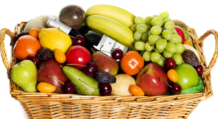As reported in High Plains Journal, discussions surrounding food prices—including retail, restaurant and the impacts of the pandemic on each—were held during the breakout session Food Price Outlook Current and Forecasted Trends at the 89th annual U.S. Department of Agriculture Ag Outlook Forum, held virtually Feb. 24 and 25.
Matthew MacLachlan, economist, USDA Economic Research Service, spoke about how historical food price inflation has affected the retail level, recent pandemic and non-pandemic related price changes and his projections for 2022 food price inflation. Andrew Harig, vice president, Tax, Trade, Sustainability and Policy Development at FMI-The Food Industry Association, explored consumer trends for at home food purchases. On the restaurant side, Hudson Riehle, senior vice president Research & Knowledge Group, National Restaurant Association, discussed the recent trends in the restaurant sector and how consumers are spending their money away from home.
When it comes to the food price outlook, McLachlan detailed how consumers tend to spend their money within the economy.
According to McLachlan, the average U.S. household spent approximately 12% of total expenditures on food, falling behind transportation and housing.
“But the two largest categories, largest growth categories, housing and transportation, are also the two largest expenditure categories,” he said. “Therefore food looks very similar to the all items inflation level.”
To disseminate it even further, MacLauchlan broke down whether the food was consumed at home or away from the home.
“We see that 55% of expenditures on food were made for food that’s consumed at home whereas 45% were on food consumed away from home,” he said.
The growth of food at home versus food away from home has differed during the past 20 years. Following the financial crisis of 2008 and 2009 food at home prices have grown more than food away from home. During the pandemic the growth rate converged some, but food at home prices increased at a faster rate than recent averages, he said.
In this context, meat prices are a very important component of food away from home as well as food at home.
“These prices have increased twice in the last two years,” MacLachlan said.
Since January 2018, he’s been tracking differences in the indexes, and near the onset of the pandemic, there were very large increases in aggregate meat, poultry and fish prices.
Looking forward, MacLachlan projects the rate of inflation for food away from home to lie between what was observed last year at about 4.5% in the historical average of about 3%. He had a couple key takeaways from 2021, though.
“In 2021, we observed high inflation in food and mostly across food categories,” he said. “Price increases were largest for meat and they increased more than any other categories. Prices didn’t decrease for any product category but were smallest for fresh vegetables.”
In 2022 he expects there still to be uncertainty related to the pandemic.
“And with this in mind, we put forward food price increase predictions between 2 and 3% for all food and 3.5 and 4.5% for food away from home,” he said.
Industry association
Harig spoke a little bit about retail food price outlets and particularly, what he’s seeing in consumer trends, and the way inflation and supply chain challenges are changing consumer behavior. The most challenging year for consumers when it came to food prices was 2021.
“In some ways, it’s even more difficult than 2020,” Harig said. “We saw three factors, really, in play. Those, I don’t think will surprise anyone, COVID, supply chain disruptions and inflation.”
Those three items continue to linger and he believes they will continue into the first half of 2022. He hopes the second half of the year will go smoother.
Realistically the term supply chain is being used and Harig said it should be chains.
“It’s really thousands of individual supply chains that have to come together, integrate and work in order to create the products and get them to the shelves on time for consumers,” he said.
COVID increased demand on the good side of the economy, and that’s stayed “really high,” according to Harig, and for him it’s been amazing how resilient the American customers have been and how much demand there is.
“At the same time, in order to meet that demand, the supply chain has had to adapt and had to meet those challenges in an incredibly difficult situation, where you’re dealing with COVID and illnesses related to that and these other factors here,” he said.
In the food retail industry, Harig is hearing about labor-related issues that are spread across the entire supply chain—from field to table.
“It’s at the agricultural sector, it’s at the production level, and it’s at the retail level,” he said. “It’s incredibly difficult to get enough people to fill jobs and when you get them, to keep them.”
Transportation is tied closely to labor.
“That extends, not just on seaports, but is across the board. Rail, trucking, it is all the different transportation sectors,” Harig said. “Because of some of the back-ups at ports, those have gotten more attention than other aspects of the supply chain.”
Harig does expect by the second half of 2022—barring any kind of external factors—to see supply chains start to catch up.
“We’ll see some of the shortages ease and some of the pressure on the industry and on consumers relax a little bit,” he said. “That’ll set the stage for inflation to follow suit.
Harig sees a “huge increase in food inflation that we haven’t really seen going forward.”
“I would say that if you look at inflation at the economy, generally, food is actually pretty on par with where we’re at,” he said. “People feel it more, right? Not everyone’s out there buying a TV or buying a car. Pretty much everyone’s going to the grocery store. They tend to feel food price inflation in a way they don’t feel other categories.”
This is an economy wide problem that everyone has to deal with, but food inflation is more of a personal issue for a lot of people. Numbers are actually on par with larger economy—a good sign—instead of running head of it. But there are still significant increases he sees going forward.
“We think they’ll probably persist through at least a good chunk of this year,” he said. “The supply chains need to catch up, we need to get on the other side of COVID and other challenges have to be addressed.”
At the restaurant
Riehle discussed the current state of the restaurant industry and where he expects it to go during the remainder of the year. All meals, snacks, alcohol from restaurants including all takeout meals and beverages, are tied to the restaurant industry. The off-premises market includes takeout, delivery, drive-through and curbside.
“Back in 2020, during the depths of the pandemic, the association actually forecasted restaurant industry sales to reach a record high of $899 billion,” he said. “Obviously that did not occur. It came in around $659 billion, which is a $240 billion shortfall or a drop of 27%.”
By 2021, restaurant officials were estimating $800 billion for 2022, and the real numbers will be known later.
“The industry will continue to improve. But it’s very important to remember that 2022 will definitely be another year of transition for the restaurant industry,” he said. “One of the most important macroeconomic indicators we follow is what goes on with national employment.”
Even though there’s been recovery from “the depths of the pandemic” employment rates on the national level are still down 3.6 million jobs.
“The reason that’s important for the restaurant industry is because when somebody is employed, they have less time for at home meal preparation, and also they have additional income to support restaurant spent,” Riehle said.
How consumers spend their money in America is very important to the restaurant industry.
“The restaurant industry is an industry consumers want to use. They want to spend their dollars in,” he said. “So from the restaurant operator perspective, it’s very important to facilitate and meet that need.”




